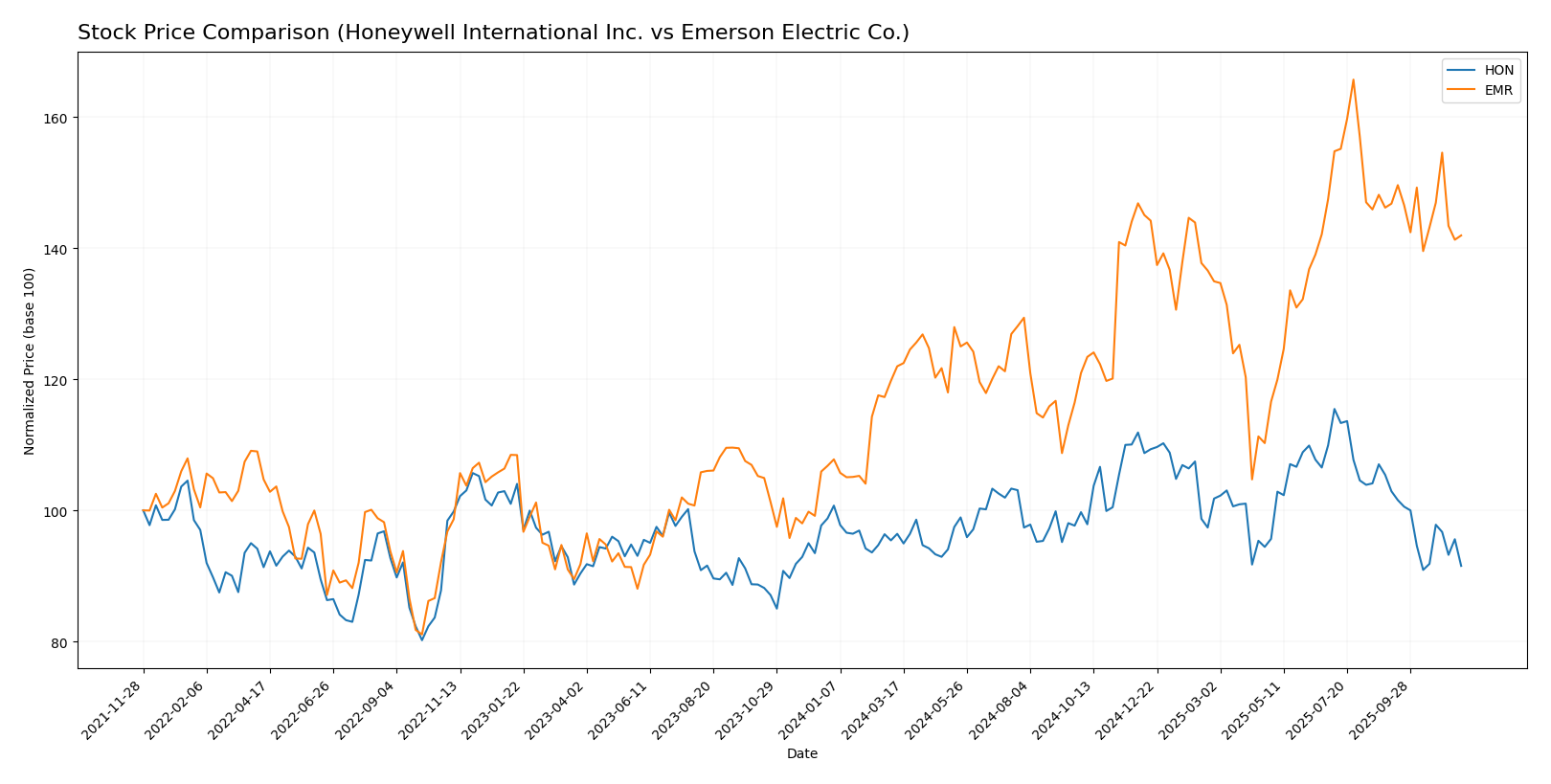In today’s fast-paced industrial landscape, choosing the right company to invest in can be a challenging task. In this analysis, I will compare Honeywell International Inc. (HON) and Emerson Electric Co. (EMR), two leading players in the industrial sector known for their innovative strategies and diverse product offerings. Both companies operate within overlapping markets, yet they each bring unique strengths and growth potential to the table. Join me as I explore which of these firms might be the more compelling choice for your investment portfolio.

Table of contents
Company Overview
Honeywell International Inc. Overview
Honeywell International Inc. (Ticker: HON) is a diversified technology and manufacturing company that specializes in various sectors, including aerospace, building technologies, performance materials, and safety solutions. Founded in 1906 and headquartered in Charlotte, North Carolina, Honeywell operates globally with a workforce of 102K employees. The company emphasizes innovation in automation and control systems, and its extensive product offerings range from auxiliary power units to advanced building management software. Honeywell’s market position is strengthened by its commitment to sustainability and efficiency, particularly through its Performance Materials and Technologies segment, which focuses on reducing global warming potential in manufacturing.
Emerson Electric Co. Overview
Emerson Electric Co. (Ticker: EMR) is a prominent technology and engineering firm that delivers automation and commercial solutions across various industries, including oil and gas, power generation, and residential markets. Established in 1890 and based in Saint Louis, Missouri, Emerson employs approximately 73K individuals. The company operates through two main segments: Automation Solutions, which provides advanced instrumentation and control systems, and Commercial & Residential Solutions, focusing on heating, air conditioning, and refrigeration technologies. Emerson is recognized for its innovative approach to energy efficiency and sustainability, positioning itself as a leader in the industrial and commercial sectors.
Key similarities and differences
Both Honeywell and Emerson operate in the industrial sector and focus on technological innovation to enhance efficiency and sustainability. However, Honeywell has a broader range of segments, including aerospace and building technologies, while Emerson specializes more in automation and commercial solutions. This distinction shapes their market strategies and target industries, with Honeywell leaning towards diverse applications and Emerson focusing on specific industrial needs.
Income Statement Comparison
Below is a comparative analysis of the income statements for Honeywell International Inc. and Emerson Electric Co. for their most recent fiscal years, providing insight into their financial performance.
| Metric | Honeywell (HON) | Emerson (EMR) |
|---|---|---|
| Market Cap | 122.02B | 74.94B |
| Revenue | 38.50B | 18.02B |
| EBITDA | 9.61B | 4.86B |
| EBIT | 8.27B | 3.17B |
| Net Income | 5.71B | 2.29B |
| EPS | 8.76 | 4.06 |
| Fiscal Year | 2024 | 2025 |
Interpretation of Income Statement
In analyzing the income statements, Honeywell demonstrated a solid revenue growth, increasing from 36.65B in FY2023 to 38.50B in FY2024. The net income also saw an uptick from 5.66B to 5.71B, indicating stable profitability. In contrast, Emerson’s revenue increased from 17.49B in FY2024 to 18.02B in FY2025, showcasing a positive growth trend. However, their latest net income of 2.29B suggests fluctuations in their profitability, especially when compared to prior years. Overall, Honeywell appears to maintain stronger margins and consistent growth compared to Emerson’s performance.
Financial Ratios Comparison
The table below presents a comparative analysis of the most recent financial ratios for Honeywell International Inc. (HON) and Emerson Electric Co. (EMR), providing insights into their financial health and operational efficiency.
| Metric | Honeywell (HON) | Emerson (EMR) |
|---|---|---|
| ROE | 30.64% | 11.30% |
| ROIC | 10.48% | 4.62% |
| P/E | 25.77 | 32.42 |
| P/B | 7.90 | 3.66 |
| Current Ratio | 1.31 | 0.88 |
| Quick Ratio | 1.01 | 0.65 |
| D/E | 1.73 | 0.65 |
| Debt-to-Assets | 0.43 | 0.31 |
| Interest Coverage | 7.44 | 9.44 |
| Asset Turnover | 0.51 | 0.43 |
| Fixed Asset Turnover | 6.22 | 6.28 |
| Payout Ratio | 50.87% | 51.98% |
| Dividend Yield | 1.97% | 1.60% |
Interpretation of Financial Ratios
Honeywell exhibits stronger performance in key ratios such as ROE and ROIC, indicating efficient use of equity and capital. Its higher current and quick ratios suggest better liquidity compared to Emerson, which is critical for covering short-term obligations. However, Emerson shows a lower debt-to-assets ratio, reflecting a more conservative leverage strategy. Both companies have similar payout ratios, but Honeywell’s higher dividend yield may attract income-focused investors. Overall, while both companies have solid fundamentals, Honeywell appears to have the edge in profitability and liquidity.
Dividend and Shareholder Returns
Honeywell International Inc. (HON) consistently pays dividends, with a current annual yield of 1.97% and a payout ratio of approximately 51%. This suggests a balanced approach to returning capital while maintaining sufficient cash flow for growth. Their commitment to share buybacks further supports shareholder value.
Conversely, Emerson Electric Co. (EMR) also offers dividends, with a yield of 1.60% and a payout ratio of 52%. This stability, coupled with ongoing share repurchase programs, indicates a strategy that favors both immediate returns and long-term growth. Overall, both firms exhibit solid practices that align with sustainable value creation for shareholders.
Strategic Positioning
Honeywell International Inc. (HON) holds a significant market share in various sectors, particularly in aerospace and building technologies, leveraging its diversified product range. With a market cap of 122B and a beta of 0.945, it faces competitive pressure from Emerson Electric Co. (EMR), which specializes in automation and residential solutions, boasting a market cap of 75B. Both companies are navigating technological disruptions while maintaining robust growth strategies, ensuring their positions in the evolving industrial landscape.
Stock Comparison
In this analysis, I will focus on the stock price movements and trading dynamics of Honeywell International Inc. (HON) and Emerson Electric Co. (EMR) over the past year, highlighting key fluctuations and trends that may impact investor decisions.

Trend Analysis
Honeywell International Inc. (HON) has exhibited a bearish trend over the past year, with a percentage price change of -5.57%. The stock reached a high of 240.4 and a low of 189.29, indicating notable volatility with a standard deviation of 12.17. Recently, from September 14, 2025, to November 30, 2025, the stock has declined by -9.11%, with a trend slope of -1.45, suggesting a continuation of the downward trajectory and a state of deceleration.
Emerson Electric Co. (EMR), on the other hand, has shown a bullish trend with a significant price change of 39.71% over the same period. The stock’s highest price was 149.63 and the lowest was 93.98, also reflecting considerable volatility, marked by a standard deviation of 12.83. In the recent analysis period from September 14, 2025, to November 30, 2025, the price change was slightly negative at -1.27%, with a trend slope of -0.16, indicating a deceleration in the bullish momentum.
In summary, while HON faces challenges with a bearish outlook, EMR maintains a strong overall performance despite recent fluctuations. This analysis underscores the importance of continuous monitoring of stock trends and performance metrics for informed investment decisions.
Analyst Opinions
Recent analyst recommendations for Honeywell International Inc. (HON) indicate a solid “Buy” rating with a B+ score, reflecting strong return on equity and assets. Analysts believe its robust financial health positions it well for growth, with a focus on innovative technologies. In contrast, Emerson Electric Co. (EMR) holds a “Hold” rating with a B- score, as analysts express concerns over its lower price-to-earnings ratio and moderate growth prospects. The consensus for HON is a clear “Buy,” while EMR leans toward a neutral stance for the current year.
Stock Grades
In the current market landscape, stock ratings provide crucial insights for investors. Here’s a look at the latest grades for Honeywell International Inc. and Emerson Electric Co.
Honeywell International Inc. Grades
| Grading Company | Action | New Grade | Date |
|---|---|---|---|
| B of A Securities | downgrade | Underperform | 2025-11-18 |
| TD Cowen | maintain | Buy | 2025-11-10 |
| Morgan Stanley | maintain | Equal Weight | 2025-10-28 |
| Wells Fargo | maintain | Equal Weight | 2025-10-27 |
| RBC Capital | upgrade | Outperform | 2025-10-27 |
| JP Morgan | maintain | Neutral | 2025-10-24 |
| RBC Capital | maintain | Sector Perform | 2025-10-24 |
| Barclays | maintain | Overweight | 2025-10-24 |
| JP Morgan | maintain | Neutral | 2025-10-15 |
| Wells Fargo | maintain | Equal Weight | 2025-10-06 |
Emerson Electric Co. Grades
| Grading Company | Action | New Grade | Date |
|---|---|---|---|
| JP Morgan | maintain | Neutral | 2025-11-10 |
| Barclays | maintain | Equal Weight | 2025-11-06 |
| RBC Capital | maintain | Outperform | 2025-11-06 |
| JP Morgan | maintain | Neutral | 2025-10-15 |
| Wells Fargo | downgrade | Equal Weight | 2025-10-06 |
| Barclays | upgrade | Equal Weight | 2025-08-07 |
| Stephens & Co. | maintain | Equal Weight | 2025-07-16 |
| Citigroup | maintain | Buy | 2025-07-14 |
| Barclays | maintain | Underweight | 2025-07-09 |
| B of A Securities | maintain | Buy | 2025-07-02 |
Overall, Honeywell’s ratings show a mix of stability and recent downgrades, particularly from B of A Securities, indicating potential caution for investors. Emerson, on the other hand, has maintained a generally stable outlook, albeit with some recent downgrades, suggesting a need for careful monitoring.
Target Prices
Based on recent consensus data, here are the target prices for Honeywell International Inc. (HON) and Emerson Electric Co. (EMR).
| Company | Target High | Target Low | Consensus |
|---|---|---|---|
| Honeywell International Inc. | 258 | 230 | 244.2 |
| Emerson Electric Co. | 155 | 100 | 121.62 |
For Honeywell, the consensus target price of 244.2 indicates a potential upside from the current price of 192.19. Similarly, Emerson’s consensus of 121.62 suggests room for growth compared to its current price of 133.38. Overall, analysts appear optimistic about both companies’ future performance.
Strengths and Weaknesses
The following table outlines the strengths and weaknesses of Honeywell International Inc. (HON) and Emerson Electric Co. (EMR) based on the most recent data.
| Criterion | Honeywell International Inc. (HON) | Emerson Electric Co. (EMR) |
|---|---|---|
| Diversification | High (multiple sectors) | Moderate (focused sectors) |
| Profitability | Strong net margin (14.82%) | Moderate net margin (12.73%) |
| Innovation | High R&D investment | Moderate R&D investment |
| Global presence | Strong global operations | Growing international reach |
| Market Share | Significant in industrials | Competitive in machinery |
| Debt level | Moderate (debt-to-equity: 1.73) | Low (debt-to-equity: 0.65) |
Key takeaways: Honeywell exhibits strong diversification and profitability, while Emerson shows lower debt levels and a focused sector approach. Both companies have their unique strengths that can appeal to different investment strategies.
Risk Analysis
In the following table, I present a comparative analysis of the key risks associated with Honeywell International Inc. (HON) and Emerson Electric Co. (EMR).
| Metric | Honeywell (HON) | Emerson (EMR) |
|---|---|---|
| Market Risk | Moderate | High |
| Regulatory Risk | Moderate | High |
| Operational Risk | Low | Moderate |
| Environmental Risk | Moderate | High |
| Geopolitical Risk | Moderate | Moderate |
Both companies face significant market and regulatory risks, particularly in light of increasing regulations and market volatility. Notably, Emerson’s higher exposure to market fluctuations could impact its performance more severely compared to Honeywell.
Which one to choose?
When comparing Honeywell International Inc. (HON) and Emerson Electric Co. (EMR), the fundamental metrics and stock trends reveal contrasting profiles. Honeywell shows strong profit margins, with a net margin of 14.82% and a solid return on equity (ROE) of 30.64%. Its stock trend has been bearish, with a recent price decline of 5.57%. In contrast, Emerson has displayed impressive price growth of 39.71%, although its profit margins are lower, at 12.73%. Analysts rate Honeywell at B+, suggesting a stronger overall performance than Emerson’s B-.
Investors focused on growth may prefer Emerson due to its bullish trend, while those prioritizing stability and robust fundamentals may favor Honeywell. However, both companies face risks from competition and market volatility.
Disclaimer: This article is not financial advice. Each investor is responsible for their own investment decisions.
Go further
I encourage you to read the complete analyses of Honeywell International Inc. and Emerson Electric Co. to enhance your investment decisions:



